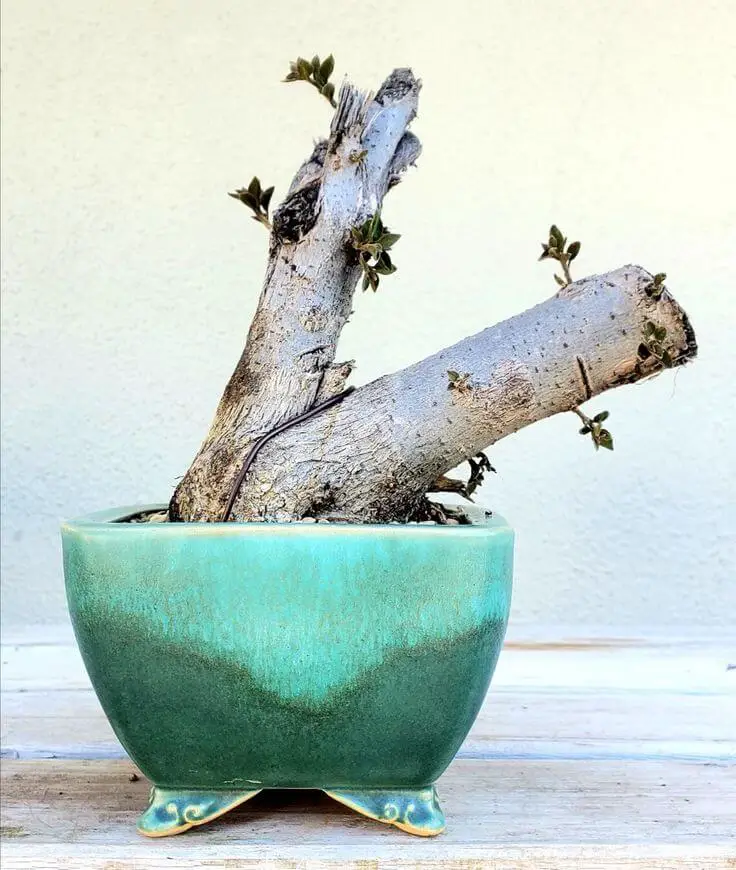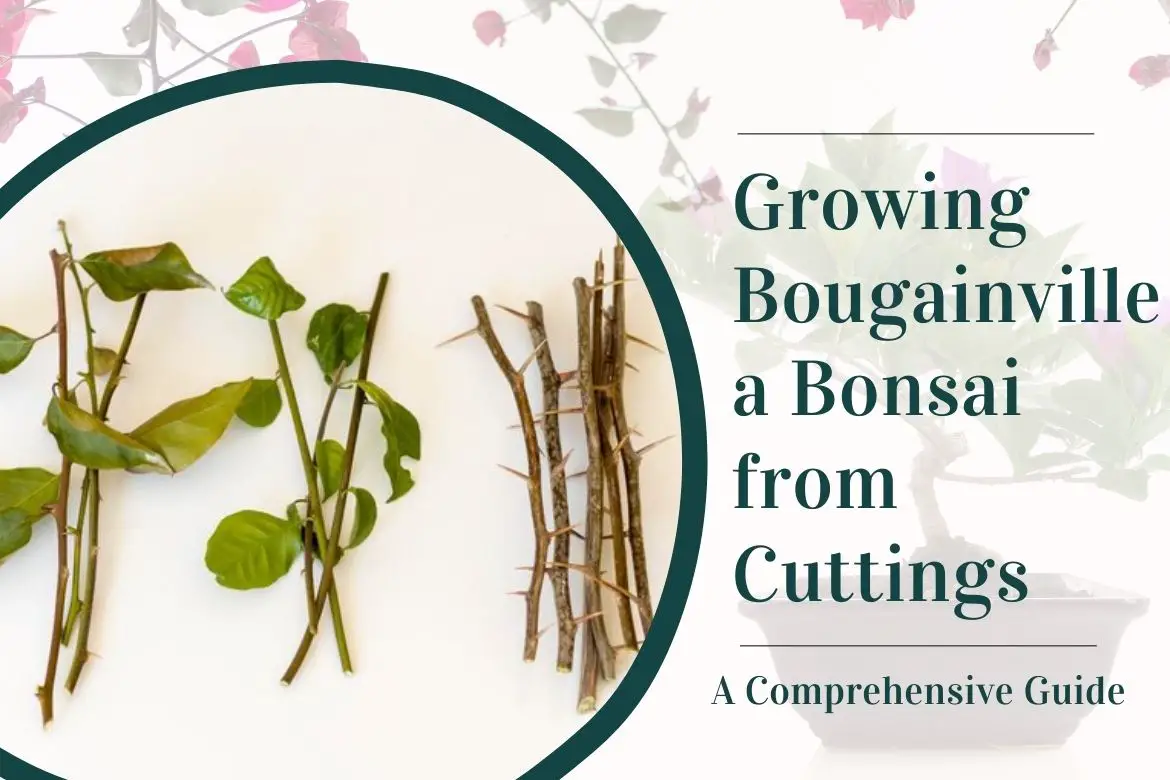Bougainvillea bonsai, with its vibrant blooms and graceful form, is a captivating addition to any bonsai enthusiast’s collection.
While growing this stunning bonsai tree may seem challenging, propagating Bougainvillea from cuttings can be a rewarding and straightforward process.
In this guide, we will explore the step-by-step techniques to successfully grow Bougainvillea bonsai from cuttings.
Plus I have also included a secret tip for growing softwood cutting. Check it out in the softwood cutting section.
Selecting the Right Cuttings
Bougainvillea can be grown by both softwood and hardwood cuttings. However, which ever cutting you decide to use, make sure that the cuttings are taken from a healthy tree.
Remember, hardwood cuttings are much more preferable if you live in a colder climate.
Softwood cuttings are preferred for warmer climates.
Also, when choosing a bougainvillea variety for bonsai, consider factors such as the climate in your region, the desired color of the bracts, and the overall growth habit.
Some popular varieties for bonsai include “Barbara Karst” with vibrant red bracts, “Singapore Pink” with delicate pink bracts, and “Orange King” with stunning orange-colored bracts. Continue reading Bougainvillea Bonsai care.
Research the characteristics of different varieties to find the one that aligns with your preferences and growing conditions.
Growing Bougainvillea Bonsai from hardwood Cuttings
It is possible to use hardwood cuttings of any size. It is possible to use thin hardwood branches with spines or even a mature Bougainvillea trunk or branch. See the pictures below:


Steps and tips to grow Bougainvillea bonsai using hardwood cuttings.
- Use a very sharp tool if you are taking large cuttings from a mature Bougainvillea plant to achieve clean cuts. Read about bonsai tools Here. Also, read about how to keep your bonsai tools clean Here.
- Seal the cuts with glue or resin as soon as possible to prevent moisture loss. This moisture inside the trunk helps in quicker germination of roots.
- You should always treat the bottom part of the cutting as the part from which the roots will emerge. It is not a good idea to plant the cutting upside down.
- Now dip the bottom part of the cutting in a bucket of water for 24 to 48 hours. It is preferable to use rainwater, but regular water can also be used. Make sure that the water is not too alkaline.
- After 1 to 2 days, remove the cuttings from the water. When you see tiny white spots on the part of the trunk that was submerged in water, it means the cuttings are ready to be planted.
- These white spots are the places where the roots will develop.
- You can plant the cutting in regular garden soil or a mixture of 50% sand and 50% compost. You can even use 100% all purpose sand, and once the cuttings are planted in the sand, cover the sand with garden soil. At this point you can also apply some rooting hormone, but its not necessary.
- Water the soil.
- If you have a humid climate, you can leave the pot as it is. However, if your climate is dry, cover the pot with plastic.
- It should take about 10 days for the leaves to appear on the cutting. In addition, you will notice tiny green buds emerging from the cutting.
- The Bougainvillea plant grows pretty quickly. In just 10 days you can expect a healthy root growth. However, these roots are still young and need protection.
- In about 20 days, you can expect lush green healthy leaves on some parts of the cuttings. Also, the tree will produce some aerial roots from the bottom part of the trunk.
- All that being said, the cutting is still fragile at this point, and the roots of the plant are also very young. Therefore, protect the cutting from harsh weather and cover it with a plastic for about 30-40 days. The cutting should be covered in leaves by then.
- It should be gradually exposed to sunlight after 30-40 days. This plant will die if it is exposed to full sunlight suddenly.
Growing Bougainvillea Bonsai from softwood Cuttings

Steps and tips to grow Bougainvillea bonsai using softwood cuttings.
- Take approximately 8 inch long softwood cuttings. In most cases, I take an 8-inch cutting, but there is no hard and fast rule. The length of the cutting should be between 5 and 9 inches.
- At the bottom, ensure that the cuts are approximately 45 degrees.
- It is best to make a cut near a node of the cutting. As this is the place where roots are more likely to develop.
- To ensure a sharp cut, make sure you use a sharp tool.
- Make sure all new growth is removed, including the leaves. This is important as you need your cutting to just focus all the energy on development roots.
- In case you are planning to pot the cuttings at a later time, keep the bottom end of the cutting submerged in water.
- The cuttings are now ready to be planted in the pot.
- Secret tip 1: You can use rooting hormone. Alternatively, you can use honey, cinnamon powder, or Aloe vera gel instead of rooting hormone. I have also found these to work well.
- Secret tip 2: You can use a hammer to gently pound the bottom of the cutting instead of planting it like that. You don’t need to make a pulp from the stem, just smash it gently to soften it. There will be slight cracks on the bottom of the cutting and the bark will also be torn. There is no need to be afraid. By doing this, you will be able to germinate roots more quickly.
- A mixture of 40% garden soil, 20% fine sand, 20% peat, and 20% compost can be used to plant this cutting. As a potting medium, you can even use 100% sand. It is important to remember that Bougainvillea can be propagated with a wide range of soil recipes. You may use whatever you prefer or is available.
- Ensure the cutting sits firmly in the soil by firming the soil around it after planting.
- Water the soil.
- 40-60 days after cuttings are planted, roots will have established. The cuttings should have a lush canopy of leaves after almost two months. However, do not expose this plant to full sun just yet. Wait for at least 3-4 months to gradually introduce the plant to full sunlight.
- Approximately 4 months from now, you will have a small flowering plant.
Will bougainvillea cutting root in water
Yes. It is possible to root bougainvillea cuttings in water. However, the success rate is low as the setup requires close monitoring and constant care.
That being said, by growing the plant with this method, you can ensure that the plant you have grown is super hardy and will survive a lot of adverse conditions relatively easily.
It is especially suitable for bonsai growers who are experiencing problems with their bougainvillea plants not surviving. Example: After 1-2 years the plants die or cannot produce flowers.
Another advantage of this method is that the roots develop relatively faster than those in the soil. In this method, however, leaves and branches will develop slowly.
Take the cuttings, removing leaves and thorns, and scarifying the bottom (scraping off the green barkat the bottom). The cuttings are then placed in water. Place the container near a window. You should see roots forming after about 3-4 weeks.
Every 3-4 days, you will also need to change the water. Additionally, you should clean the cuttings every week, as they will develop a thin layer of algae. If you use a transparent container, this algae formation will be more obvious. You can use translucent or opaque containers to slow down algae growth.
Another thing you can do is submerge them in water every once in a while. You are exposing the cuttings to harsh conditions, which will further harden them. You should only do this for 10 to 15 minutes.
After 1.5 – 2 months, these cuttings are ready to be planted in the soil.
Conclusion
Remember to select healthy cuttings, follow the propagation process carefully, gradually uncover the cuttings, trim and shape the bonsai, and repot when necessary.
By following these steps, you can cultivate a beautiful Bougainvillea bonsai that will bring joy and beauty to your bonsai collection.

